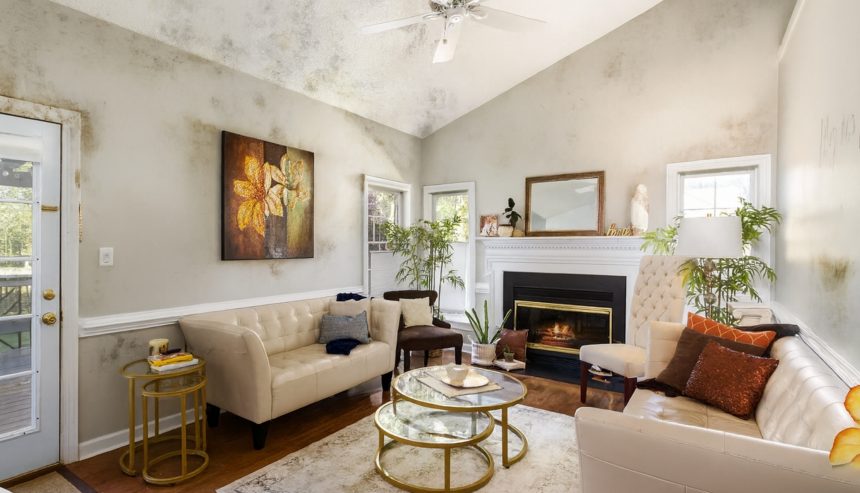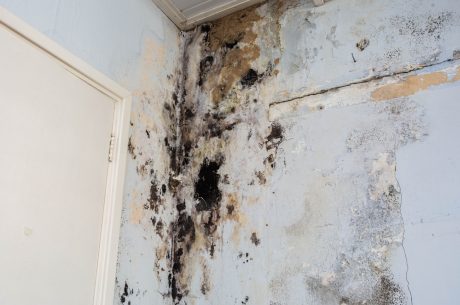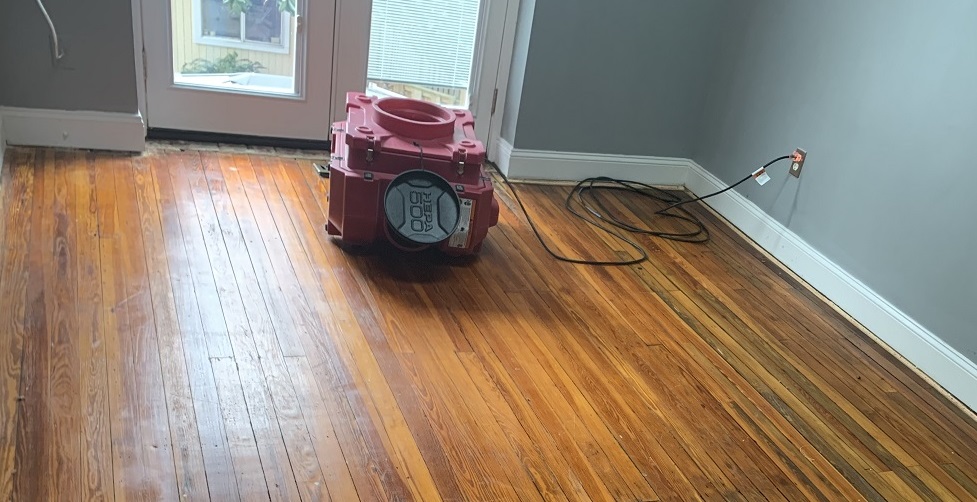Elegant design, refined finishes, and spacious layouts define McLean’s luxury homes. But beneath that polished exterior, a silent intruder could be at work, mold.
While it’s often associated with neglected or aging buildings, mold can thrive in even the most high-end residences, especially when hidden behind crown molding or inside drywall. For those dealing with mold in McLean luxury homes, understanding the risks is key to protecting both property and health.
What Is Mold and Why Should You Care?
Mold is a fungus that thrives in moist, warm, and poorly ventilated environments. Its spores can easily travel through the air and land on a wide range of surfaces, making it easy for mold to spread. While a small amount of mold may not pose a major threat, certain types, like black mold, can lead to significant health risks and even structural damage. Even homes that look spotless on the outside can harbor hidden conditions that allow mold to grow silently behind walls for weeks or even months without detection.
Why Mold Can Thrive in McLean’s Luxury Properties
McLean’s seasonal humidity and frequent rainfall make moisture management a top priority for homeowners. Mold in McLean luxury homes is more common than people realize, often due to a combination of design features and climate factors. Even high-end properties with modern finishes can experience mold growth when airflow is poor or insulation is outdated.
Finishes like hardwood, marble, and layered paneling add elegance but also create opportunities for hidden moisture buildup. A small plumbing leak behind a wall or near the ceiling might go unnoticed for weeks. A drywall, commonly used in luxury homes, is particularly vulnerable because of its porous nature and tendency to retain moisture.
When these factors, persistent moisture, poor ventilation, and hidden spaces, come together, they create the perfect environment for mold to flourish unnoticed. Over time, this can lead to serious problems for both your home and your health, especially when early signs of mold behind drywall are missed during routine checks.
Common Places Mold Hides in Luxury Homes
Not all mold is visible. In fact, some of the most severe cases occur behind materials that look clean and intact. Mold can spread silently for weeks or even months before any outward signs appear.
Just because a surface looks dry or undamaged doesn’t mean the space behind it is mold-free. Below are a few common places where mold often hides in luxury homes, making it especially important to early signs of mold behind drywall.
Behind Drywall
The drywall is porous and easily absorbs moisture from leaks or condensation. Once mold begins growing behind it, you may not notice until there’s discoloration, warping, or a musty smell. This is especially common in cases of mold in McLean luxury homes, where aesthetic design often hides the issue.
Underneath Crown Molding
Decorative features like crown molding can trap moisture against walls, especially if installed near poorly sealed roofs or windows. Over time, the hidden space between the molding and drywall becomes a favorable mold environment, often missed during routine cleaning.
Around Windows and Skylights
Even small gaps in window caulking or skylight seals can let in water. If not quickly addressed, mold can develop along windowsills or behind trim, often only detected during deep maintenance or renovations.
HVAC Systems and Ductwork
Mold spores can easily spread through ductwork. If the system is not cleaned regularly or if condensation forms inside the vents, mold colonies can develop and spread throughout your home’s air supply.

Health and Structural Risks of Hidden Mold in McLean Luxury Homes
Ignoring mold can affect more than your home’s appearance; it can impact your well-being and the structure of your property. Mold can have serious effects on health and cause significant structural damage, so knowing some of the key health and structural risks is essential for every homeowner.
Health Effects
Mold spores can trigger allergies, asthma, and other respiratory issues, especially in vulnerable individuals. These symptoms often go unnoticed or are mistaken for common illnesses. Knowing what mold exposure says about your home can be an important step in recognizing and addressing potential health risks.
Structural Damage
Over time, mold weakens the materials it grows on. In drywall, it can compromise wall integrity; in wood, it can cause rot. Left unchecked, this damage can be costly, requiring major repairs or complete replacements of affected structures. Preventing mold in McLean luxury homes also means protecting long-term investment value and structural integrity.
How to Detect Mold Without Tearing Down Walls
You don’t need to tear down drywall to suspect mold. Often, early signs and simple inspections can help you catch problems before they get worse. Being proactive and paying attention to subtle clues can save you from costly repairs.
There are clear indicators to watch for and easy steps you can take to spot hidden mold in McLean luxury homes
Signs of Mold Behind Drywall
Noticing any of these signs early can help you catch mold growth behind drywall before it causes more serious problems. Look out for subtle changes like
- A persistent musty odor
- Discolored patches or stains on walls
- Warped or bulging drywall
- Peeling wallpaper or bubbling paint
- Worsening allergy-like symptoms indoors
Routine Checks You Can Do Yourself
Keeping an eye out for these simple signs can help you detect mold early and prevent bigger issues. Regularly check:
- Inspect hidden corners, closets, and behind furniture for moisture
- Check ceilings and crown molding after heavy rains
- Monitor humidity levels with a hygrometer
- Use dehumidifiers in basements or poorly ventilated areas
- Listen for any dripping sounds behind walls
Steps to Remove and Prevent Mold in Upscale Homes
When mold is found, the solution should be tailored to protect your home’s design while thoroughly eliminating the issue, which will help in preventing mold in McLean luxury homes.
Professional Mold Remediation Services
Certified mold remediation professionals use specialized tools, like infrared cameras and moisture meters, to detect mold without damaging the home’s interior.
They then safely remove affected materials and treat surfaces with antimicrobial solutions. For homeowners looking for guidance on cleanup practices, the EPA’s guide to mold cleanup is a reliable starting point.
Upgrading Ventilation Systems
Proper airflow is essential in mold prevention. Upgrading exhaust fans, sealing ducts, and improving HVAC efficiency helps maintain consistent indoor humidity and reduce the risk of moisture buildup.
Use of Mold-Resistant Materials
In future renovations or repairs, consider mold-resistant drywall, sealants, and insulation. These materials are particularly useful in moisture-prone areas like bathrooms, kitchens, and basements. Using such materials is one of the smartest ways to prevent mold in McLean luxury homes from reappearing.
Moisture Management and Routine Maintenance
Regular care and attention can greatly reduce the risk of mold growth. These routines are especially useful when trying to detect early signs of mold behind drywall before they escalate; therefore, make sure to:
- Clean and inspect gutters regularly
- Repair leaks promptly
- Ensure proper grading around your home’s foundation
- Schedule annual mold inspections, especially if you’ve had previous issues
Why McLean Homeowners Should Take Mold Seriously
The presence of mold isn’t just a cosmetic issue; it’s a serious threat to your investment and your family’s well-being. Because it often grows in hidden areas, many homeowners don’t realize there’s a problem until it becomes widespread.
Being proactive with maintenance, monitoring, and inspections can help preserve both your health and the long-term value of your property. This is especially important when dealing with mold in McLean luxury homes.
Conclusion
Mold doesn’t discriminate between old and new, modest or luxury; it grows wherever moisture lingers. In McLean’s upscale homes, beautiful details like crown molding and drywall can unintentionally hide these problems.
Knowing what to watch for, how to detect early signs of mold behind drywall, and who to call for help can save you from costly repairs and long-term health issues. Mold prevention is an investment in both comfort and peace of mind.
FAQs
Q1: Are luxury homes more prone to mold than standard homes?
Not necessarily. However, the materials and features common in luxury homes, like crown molding, detailed drywall, and complex layouts, can create more hidden spaces for mold to grow if moisture is not well controlled.
Q2: How can I tell if I have mold behind drywall without opening the wall?
Look for musty odors, bubbling paint, or unexplained health symptoms. Thermal imaging and professional inspections can help detect mold without demolition.
Q3: Is it safe to remove mold on my own?
Small surface mold in non-porous areas can sometimes be cleaned, but hidden or large mold problems require professional remediation to ensure it’s safely and thoroughly removed.



